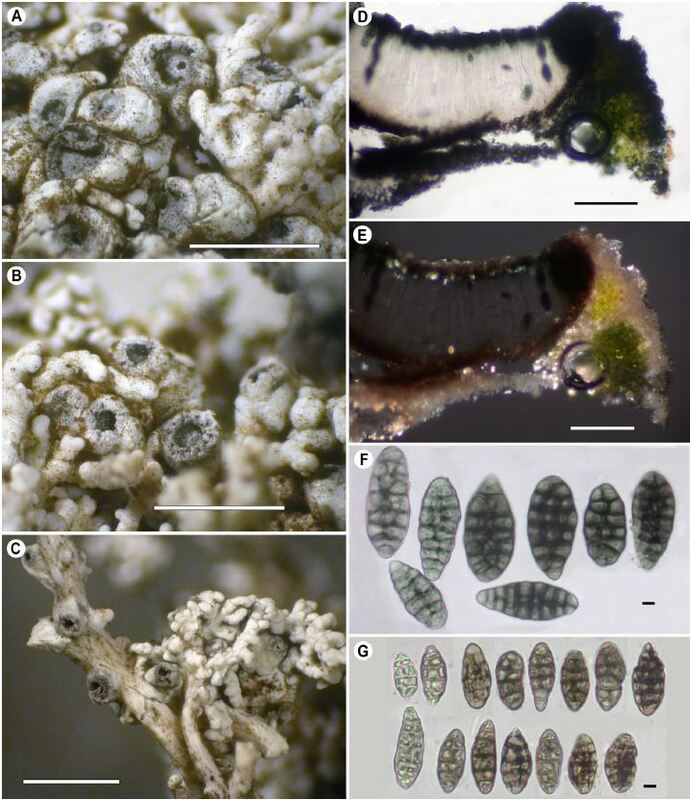ORIGINAL ARTICLE
A new species of Diploschistes (Lecanoromycetes) occurring on Stereocaulon from the Pacific Northwest of North America
1
The Field Museum, 1400 S. DuSable Lake Shore Drive, Chicago, IL
60605, USA
2
Dept. Botany & Plant Pathology, 2701 SW Campus Way, Oregon
State University, Corvallis, OR 97331 USA
Publication date: 2023-12-29
Plant and Fungal Systematics 2023; 68(2): 335-339
KEYWORDS
ABSTRACT
We describe Diploschistes stereocaulorum as a new species of lichenized fungi
growing on phyllocladia and stalks of Stereocaulon in the Pacific Northwest of North
America. The larger ascospores of this species, the absence of a noticeable thallus, and the
ITS barcode locus distinguish it from D. muscorum, which has been reported as growing
on Stereocaulon, but has smaller ascospores and a distinct thallus. In phylogenetic reconstruction,
the new species is sister to D. diacapsis, albeit without support.
FUNDING
NO
REFERENCES (22)
1.
Friedl, T. 1987. Thallus development and phycobionts of the parasitic lichen Diploschistes muscorum. The Lichenologist 19: 183–191. https://doi.org/10.1017/S00242....
2.
Friedl, T. & Gärtner, G. 1988. Trebouxia (Pleurastrales, Chlorophyta) as a phycobiont in the lichen genus Diploschistes. Archiv für Protistenkunde 135: 147–158. https://doi.org/10.1016/S0003-....
3.
Hawksworth, D. L. 1982. Secondary fungi in lichen symbioses: parasites, saprophytes and parasymbionts. Journal of the Hattori Botanical Laboratory 52: 357–366.
4.
Katoh, K. & Toh, M. 2005. MAFFT version 5: improvement in accuracy of multiple sequence alignment. Nucleic Acids Research 33: 511–518. https://doi.org/10.1093/nar/gk....
5.
Katoh, K., Asimenos, G. & Toh, H. 2009. Multiple alignment of DNA sequences with MAFFT. Methods in Molecular Biology 537: 39–64. https://doi.org/10.1007/978-1-....
6.
Kearse, M., Moir, R., Wilson, A., Stones-Havas, S., Cheung, M. et al. 2012. Geneious Basic: An integrated and extendable desktop software platform for the organization and analysis of sequence data. Bioinformatics 28: 1647–1649. https://doi.org/10.1093/bioinf....
7.
Lumbsch, H. T. 1987. Eine neue Subspecies in der Flechtengattung Diploschistes aus der Südhemisphäre. Herzogia 7: 601–608. https://doi.org/10.1127/herzog....
8.
Lumbsch, H. T. 1988. The identity of Diploschistes gypsaceus. The Lichenologist 20:19–24. https://doi.org/10.1017/S00242....
9.
Lumbsch, H. T. 1989. Die holarktischen Vertreter der Flechtengattung Diploschistes (Thelotremataceae). Journal of the Hattori Botanical Laboratory 66: 133–196.
10.
Lumbsch, H. T. 1993. Studien über die Flechtengattung Diploschistes I. Nova Hedwigia 56: 227–236.
11.
Peksa, O. & Škaloud, P. 2011. Do photobionts influence the ecology of lichens? A case study of environmental preferences in symbiotic green alga Asterochloris (Trebouxiophyceae). Molecular Ecology 20: 3936–3948. https://doi.org/10.1111/j.1365....
12.
Poelt, J. 1958. Über parasitischer Flechten. II. Planta 51: 288–307. https://doi.org/10.1007/BF0212....
13.
Poelt, J. 1990. Parasitische Arten der Flechtengattung Rhizocarpon: eine weitere Übersicht. Mitteilungen der Botanische Staatssammlung München 29: 515–538.
14.
Poelt, J. & Doppelbaur, H. 1956. Über parasitische Flechten. Planta 46: 467–480. https://doi.org/10.1007/BF0191....
15.
Poelt, J. & Steiner, M. 1971. Über einige parasitische gelbe Arten der Flechtengattung Acarospora (Lecanorales, Acarosporaceae). Annalen des Naturhistorischen Museums in Wien 75: 163–172.
16.
Schoch, C. L., Seifert, K. A., Huhndorf, S., Robert, V., Spouge, J. L. et al. 2012. Nuclear ribosomal internal transcribed spacer (ITS) region as a universal DNA barcode marker for Fungi. Proceedings of the National Academy of Sciences of the United States of America 109: 6241–6246. https://doi.org/10.1073/pnas.1....
17.
Škaloud, P. & Peksa, O. 2010. Evolutionary inferences based on ITS rDNA and actin sequences reveal extensive diversity of the common lichen alga Asterochloris (Trebouxiophyceae, Chlorophyta). Molecular Phylogenetics and Evolution 54: 36–46. https://doi.org/10.1016/j.ympe....
18.
Stamatakis, A. 2014. RAxML version 8: a tool for phylogenetic analysis and post-analysis of large phylogenies. Bioinformatics 30: 1312–1313. https://doi.org/10.1093/bioinf....
19.
Talavera, G. & Castresana, J. 2007. Improvement of phylogenies after removing divergent and ambiguously aligned blocks from protein sequence alignments. Systematic Biology 56: 564–577. https://doi.org/10.1080/106351....
20.
Vančurová, L, Muggia, L, Peksa, O, Řídká, T, Škaloud, P. 2017. The complexity of symbiotic interactions influences the ecological amplitude of the host: A case study in Stereocaulon (lichenized Ascomycota). Molecular Ecology 27: 3016–3033. https://doi.org/10.1111/mec.14....
21.
White, T. J., Bruns, T. D., Lee, S. B. & Taylor, J. W. 1990. Amplification and direct sequencing of fungal ribosomal RNA genes for phylogenetics. In: Innis, M. A., Gelfand, D. H., Sninsky, J. J. & White, T. J. (eds), PCR Protocols, pp. 315–322. Academic Press, San Diego. https://doi.org/10.1016/B978-0....
22.
Zhurbenko, M. P. 2010. Lichenicolous fungi and lichens growing on Stereocaulon from the Holarctic, with a key to the known species. Opuscula Philolichenum 8: 9–39.
CITATIONS (1):
1.
The 2025 classification and checklist of lichenicolous fungi: documenting a rapidly growing knowledge of diversity
Paul Diederich, James D. Lawrey, Damien Ertz
The Bryologist
Paul Diederich, James D. Lawrey, Damien Ertz
The Bryologist
Share
RELATED ARTICLE
We process personal data collected when visiting the website. The function of obtaining information about users and their behavior is carried out by voluntarily entered information in forms and saving cookies in end devices. Data, including cookies, are used to provide services, improve the user experience and to analyze the traffic in accordance with the Privacy policy. Data are also collected and processed by Google Analytics tool (more).
You can change cookies settings in your browser. Restricted use of cookies in the browser configuration may affect some functionalities of the website.
You can change cookies settings in your browser. Restricted use of cookies in the browser configuration may affect some functionalities of the website.



